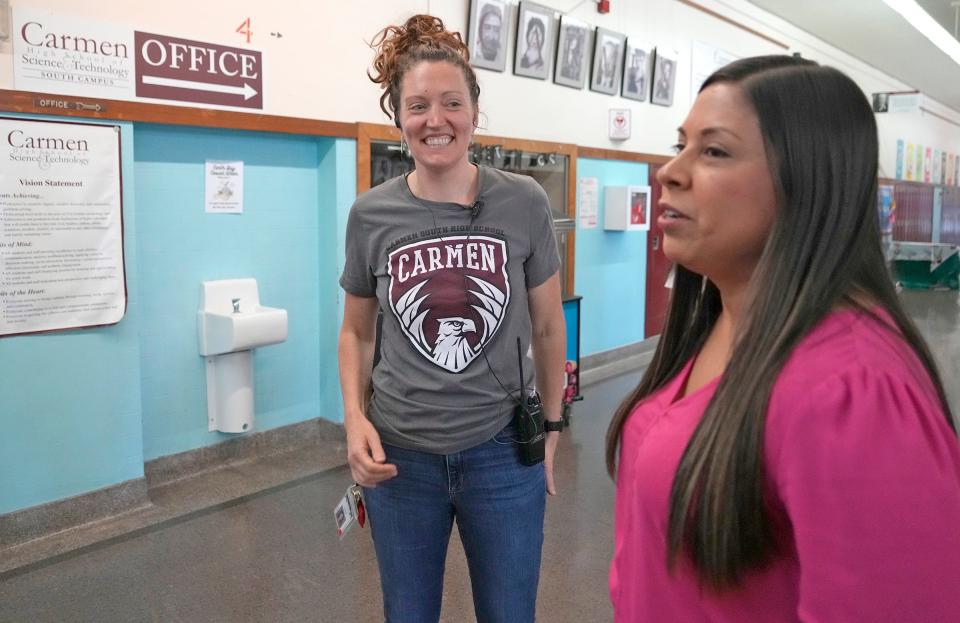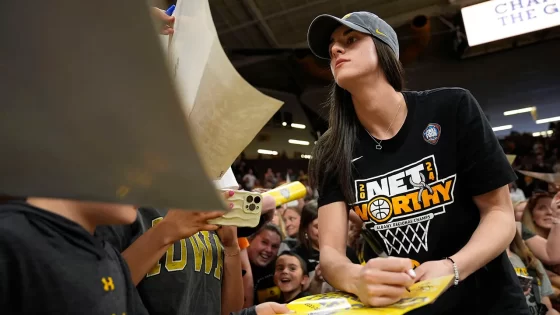Since Walker Middle School closed on Milwaukee’s southwest side in 2007, two charter schools have come to consider the building home.
For the most part, they co-exist; the students use separate entrances, eat in the cafeteria at different hours, and split time in the auditorium with a shared calendar.
Their leaders praise each other for operating successful schools, but they disagree on a key point.
Brenda Martínez, the lead teacher at Academia de Lenguaje y Bellas Artes (ALBA), says her school needs the whole building; she’s had to turn away dozens of families each year. Janis Meinke, principal of Carmen South High School, doesn’t want to move; most of her students live in the neighborhood, and it’s not clear where the school could go.

Ultimately the decision will be up to the Milwaukee School Board, which controls the leases for the building.
A proposal from board member Missy Zombor would end Carmen’s lease at the building at the end of the 2025-26 school year. It would also end Carmen’s lease for its Southeast campus, which shares a building with Pulaski High School. Supporters of each school plan to plead their case to the school board at a committee meeting Tuesday.
The Carmen Schools of Science and Technology are independently run charter schools, overseen by their own nonprofit board of directors. Their five Milwaukee campuses are considered public schools, and they receive tax funding through charter contracts mostly with Milwaukee Public Schools. They are not run or staffed by the school district, while ALBA and Pulaski are both operated by MPS.
More: Here’s what charter schools are and how they work in Wisconsin
Zombor said she brought the resolution forward now to provide time for MPS administrators to help Carmen find other possible locations in different MPS buildings. She said the core problem is that ALBA and Pulaski need space to grow, especially given that MPS has lost funding over the years because of declining enrollment districtwide.
“We’re not in a position to turn away students, and right now that is at the forefront of my mind,” Zombor said. “We’re turning away families that need resources.”
Beyond the logistical issues in the building, the debate about the future of the schools is playing out in a charged political arena around charter schools, where there are larger questions about what role public school districts should play in enabling outside organizations to run charter schools.
Proponents of independently run charter schools say they bring competition for traditional public schools, encourage innovation and produce higher test scores. Opponents argue the schools have less public oversight and pull resources away from school districts, as state funding largely follows the student. They point out that charter schools tend to serve fewer students with disabilities, leaving other public schools with comparatively higher special education costs.


Conflicts over co-locations of charter schools have come up across the country. Building-sharing became popular in the 2000s as part of a Gates Foundation-backed push to break schools into smaller schools. Since then, some districts have tried to reverse course. In February, the Los Angeles school board barred charter schools from moving into certain district buildings after teachers raised the issue during their 2019 strike.
The MPS union has thrown its support behind Zombor’s plan, arguing that Carmen’s use of MPS buildings has limited opportunities for MPS staff and students. The conservative Institute for Reforming Government and Wisconsin Institute for Law and Liberty have slammed the idea, with WILL calling Carmen a “victim of a move away from support for charter schools from public school advocates.”
Carmen doesn’t want to move, but it does have a potential property
Carmen leaders have made it clear they don’t want to leave their buildings.
“We’ve had great success here, in this location, and we’ve not wanted to mess with success,” Ivan Gamboa, chair of Carmen’s board of directors, said in an interview at the Walker campus. “We want to stay here as long as we can.”
Under Zombor’s plan, if approved by the school board, MPS administrators would be tasked finding space for Carmen in other MPS buildings that aren’t currently being used by MPS schools. Carmen leaders are concerned that such an option could be far from where their students live.
“Our priority is that we stay in the neighborhoods that we serve,” said Fabiola Ramirez, Carmen’s chief of staff. “Moving to a place that is way farther is a non-negotiable for us. Our kids need to be in the community, in the neighborhood that they live, so unless that’s true, then it’s not an option.”
About 51% of Carmen South students live within a mile of the school, according to data shared by Carmen, and another 25% are within two miles. At Carmen Southeast, about 20% live within a mile, and another 41% are within two miles.


City records show Carmen filed a special use permit for a property owned by Wheaton Franciscan at 2005 W. Oklahoma Ave., a few blocks from Carmen’s Southeast campus and about 2.5 miles from the South campus. Gamboa said Carmen has a contract to purchase the property, pending “due diligence” to determine whether they will be able to build there.
Carmen leaders said they had been interested in that property before Zombor’s resolution, as a potential location to move two of its other campuses, an elementary and middle school. However, they said they could consider the property for their South and Southeast campuses if they are kicked out of the MPS buildings.
If Carmen does build on the site, Gamboa said the project would take at least two or three years to complete, making it unclear whether it could be ready by 2026.
Henry Leonard, the school board member whose region includes Carmen Southeast, said he’s been working with Carmen for nearly three years to find a better location for the Southeast campus. He said he agreed with Zombor that Pulaski is overcrowded but didn’t agree with the plan to force Carmen to leave the building.
“I understand the resolution and why it exists, because I don’t like co-location either and never agreed with it,” Leonard said. “I don’t like that we’re doing this as a resolution versus the background work of setting up meetings and talking with people involved to see if we can work something out with them.”
Board member Marcela Garcia, whose region includes Carmen South, didn’t reply to interview requests.
Seeing high demand for its bilingual program, ALBA wants to add classroom to each grade
When Carmen launched its first campus in 2007, MPS was an eager partner. Carmen founder Patricia Hoben had begun the process to establish Carmen as a private, voucher-funded school, but former MPS administrator Marty Lexmond encouraged her to make it a charter school with a contract through MPS, the Journal Sentinel reported.
Carmen and ALBA moved into the Walker building at the same time, dividing up floors and hallways. The schools have grown since then, causing tension over use of some spaces.
The Walker building has a listed capacity of 800 students, according to a 2023 MPS report; this year the schools have enrolled over 1,000 students.
Both schools have waitlists: 265 students want a spot at Carmen South and 68 at ALBA, school leaders said.
On the ALBA side, Martínez points out many areas of the school where space is tight: Instruments are stored in a hallway, students take music lessons in an auditorium balcony, some students recently had to use a laundry room to take a standardized test, and staff use partitions to section off areas of occupied classrooms to offer counseling and speech pathology.


Veronica Ramirez, a special education teacher at ALBA, said her office is in what appears to have been a utility closet.
“Most of us (special education) teachers, we either have a space within a room so it’s really loud, or we have something that was a closet,” she said.
Martínez said the school has grown because there’s a high demand for the bilingual education ALBA offers from kindergarten through eighth grade, particularly for the middle school grades. The school also emphasizes parental involvement and volunteering. Parent Benedith Cortez said she sent her four children through the school because it felt like a family. Her daughter, Jennifer, said she appreciated the bilingual curriculum.


“I had a lot of ties to my culture; that’s what I loved the most,” said Jennifer, now a student at UW-Milwaukee. “I learned to speak English here, but I was still connected to my native language.”
If ALBA had room to expand, Martínez said the school would gradually add a class to each grade level, starting with kindergarten and growing each year.
“When a mom walks in and says, ‘Hey, this is my cousin who was able to finally get to the United States. We’re looking for seats; do you have room?’ And it’s like, you want to be able to take more of these family members and you can’t; that’s really hard,” Martínez said.


The Carmen side has its own space issues. A music group practices in the gym, for example, pushing its instruments to the side when it’s time for basketball. But Meinke said it’s not a problem.
“Do we all need more space? Absolutely. But do we make it work? Yes, because we need to be here for our students,” Meinke said.


Some Carmen South families have children at both Carmen and ALBA, or children who attended ALBA and then transferred to Carmen for high school. Parent Ana Contreras said the proposal to end Carmen’s lease “felt like the rug was pulled from underneath us.”
Jessica Alvarez’s two sons attend Carmen, and her daughter is an ALBA student. She said she feels safer knowing they’re all in the same building. It’s also a convenience for many working parents, she said.
If Carmen had to move, Alvarez said in Spanish, “I would have to move my daughter in order to have all three a little closer because, for me, it’s difficult to travel around to so many places.”
Orlando Garcia Alvarez, a junior at Carmen South, attended ALBA and said most of his friends from ALBA continued on to Carmen.
“I wanted to attend this school because of the connection,” Garcia Alvarez said. “It was always on my mind, attending this school. It kind of felt like a dream. I wanted to experience it. It’s been great, it’s up to what I expected.”


He said it was helpful to have friends already when he started high school.
“It made it significantly easier, knowing people,” he said. “I have a sort of antisocial problem and knowing these friends helped me a lot.”
Original vision for partnership between Pulaski and Carmen Southeast falls short
A few years after Carmen South opened at the Walker building in 2007, demand exceeded the school’s space, and so school leaders looked for another site.
After adding a site on the north side in 2013, Carmen added its Southeast campus at Pulaski in 2016. The fact that the building was already occupied by another high school was a selling point at the time for both Carmen and MPS.
Carmen leaders had learned about “co-location” partnerships from the Charter School Growth Fund, and they visited a model program near Houston: the since-canceled SKY partnership between Spring Branch public schools and two independently run charter schools, according to a report by the Wisconsin Evaluation Collaborative commissioned by Carmen.
Carmen Southeast and Pulaski were meant to collaborate: Students would be able to take courses at both schools, staff could learn from each other, and test scores would rise for all.
When the Wisconsin Evaluation Collaborative prepared a report on the co-location in 2020, it concluded the partnership had fallen short of its goals. Fabiola Ramirez, who said the report had been commissioned for internal use, did not provide a copy to the Journal Sentinel but allowed a reporter to take notes on it at Carmen’s offices. A summary of the report was also shared by WEC in a later evaluation of MPS charter schools.
The report found that only a few students had taken classes at the opposite schools, that the staff had not established regular collaboration, and there was “very little evidence” of academic improvement.
The report noted that Carmen leadership viewed the need for a facility “as the main, and perhaps only, reason to continue the co-location.” It added: “The future of the partnership at this point seems unclear, as Carmen’s continued interest in physical space to meet enrollment demand will be balanced against questions about whether the co-location partnership remains viable, given the lack of progress thus far toward stated goals.”
Ramirez said Carmen remains open to collaboration but acknowledged the original vision for a partnership has not been realized. MPS didn’t respond to requests to interview Pulaski’s principal.
There is one exception: Pulaski and Carmen have fielded joint sports teams. Jada Williams, who graduated in 2022 from Carmen Southeast, said she valued the chance to make friends at another school — and to have enough players to form a team. “We wouldn’t really have had teams without the other school,” she said.
Jesus Castellon, a bilingual math teacher who has taught at Pulaski for 12 years, said he remembers promises that there would be shared programs between the schools. Now, he said, he’s concerned the co-location is putting a strain on the school.
“We need that space,” he said. During his prep periods, Castellon said other teachers have to use his room to teach their classes because they don’t have their own space.
Enrollment at Carmen Southeast has been less robust than the flagship Carmen South campus. The campus is under-enrolled with space for another 100 students, Gamboa said.
Pulaski, however, has seen growth since adding an International Baccalaureate program. The school has a waitlist of about 39 students, Zombor said.
Together, Pulaski and Carmen had over 1,600 students this school year, in a building with a capacity listed as 1,467.
MPS could lose lease revenue, gain students
Another factor in the debate over the schools’ future: rent money. If the Carmen South and Southeast campuses were to leave their buildings, MPS would lose revenue from those leases.
For the Southeast campus, Carmen paid MPS $510,666 for this school year, and is scheduled to pay MPS $520,879 next year and $531,297 the following year, under the lease agreement.
At the South Campus, Carmen paid MPS $265,500 this school year, with the amount set to increase to $270,810 next year and $276,226 the following year.
Zombor said it’s possible MPS could recoup lease revenue if the district can find another location for Carmen in its buildings.
Zombor also said the moves could benefit the district financially by creating space for more students at high-demand MPS schools — students who might otherwise go to private or independent charter schools. Bringing those students into MPS schools would mean more funding for MPS.
What’s next?
Zombor’s resolution will be considered by the school board’s Accountability, Finance and Personnel Committee at its meeting Tuesday, which is open to the public and streamed on the district’s YouTube page.
The resolution would also need to be approved by the full board at a later meeting. The full board is next scheduled to meet May 30.
Journal Sentinel reporter Tom Daykin contributed to this report.
Contact Rory Linnane at [email protected]. Follow her on X (Twitter) at @RoryLinnane.
This article originally appeared on Milwaukee Journal Sentinel: Carmen charter schools won’t leave MPS buildings without a fight
Source Agencies


